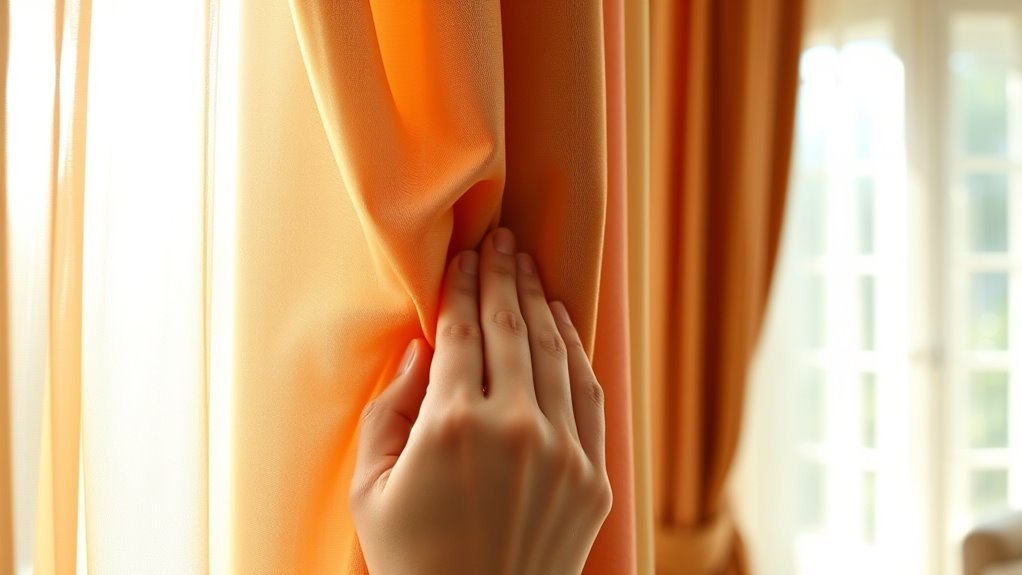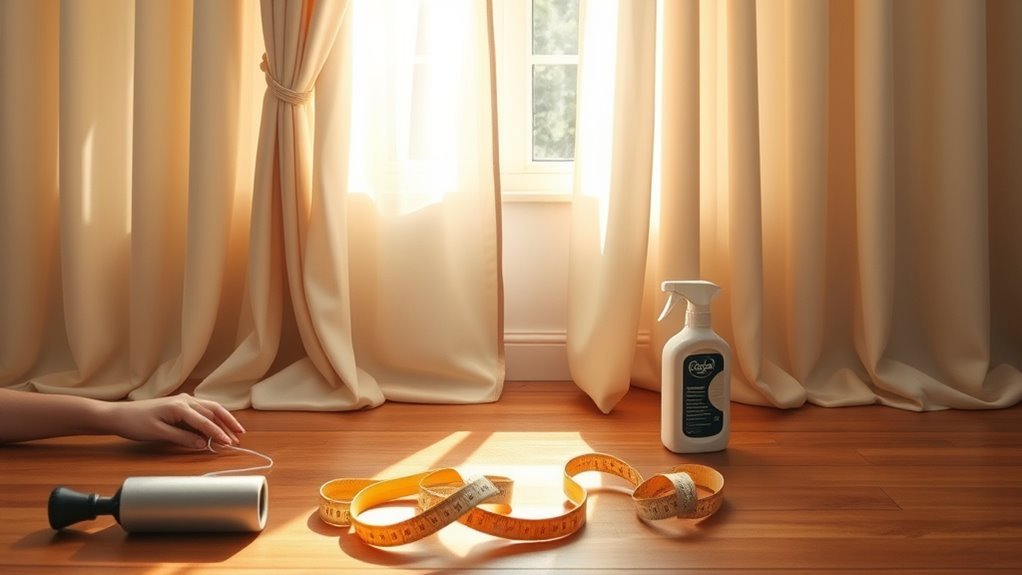Seasonal Maintenance Tips for Curtains
You should start by inspecting your curtains each season for wear, checking fabric and hardware for damage. Dust and vacuum regularly using gentle tools to keep them fresh. Clean according to fabric type—hand wash silk, machine wash cotton and synthetics. Manage moisture by ensuring proper ventilation and washing to prevent mold. When storing, wash first and keep curtains in breathable containers. Also, adjust fabric weight seasonally to enhance comfort and energy efficiency. Keep exploring for ways to repair and refresh your curtains effectively.
Inspecting Curtains for Wear and Tear

Before you immerse yourself in cleaning or repairing, take a close look at your curtains to spot any signs of wear and tear. Performing a thorough curtain inspection helps you identify weak spots, fabric thinning, or fading that could worsen over time. Pay attention to seams, hems, and areas near the edges where damage often starts. A careful wear assessment lets you decide whether you can fix minor issues or if replacement is necessary. Don’t overlook hardware like hooks and rods during your inspection, as worn attachments can cause fabric stress. By taking charge of your curtain maintenance with an honest wear assessment, you maintain control over your space’s look and avoid unexpected deterioration. This proactive approach keeps your curtains fresh and functional, giving you freedom from last-minute fixes.
Regular Dusting and Vacuuming Techniques
To keep your curtains looking fresh, you’ll want to choose the right tools for dusting and vacuuming. Knowing how often to clean them depends on factors like fabric type and room usage. Let’s explore some effective dust removal tips and a simple vacuuming schedule you can follow.
Best Tools Selection
Choosing the right tools makes regular dusting and vacuuming your curtains much easier and more effective. Start with a soft microfiber cloth or a feather duster to gently remove dust without damaging delicate fabrics or curtain rods. For deeper cleaning, a vacuum with a brush attachment works wonders, especially on heavier fabrics. Test any vacuum settings on a fabric swatch before tackling your full curtains to avoid mishaps. Remember, a lightweight handheld vacuum gives you freedom to reach tricky spots without hassle. Avoid harsh tools that could bend curtain rods or snag fabric. With the proper selection, maintaining your curtains becomes a simple, liberating routine that keeps your space fresh and inviting. You’ll appreciate how much easier upkeep feels when you have the right gear at hand.
Vacuuming Frequency Guide
Once you have the right tools ready, knowing how often to vacuum your curtains can make all the difference in keeping them looking fresh. Different curtain types demand varied care, so adjust your vacuum settings accordingly to prevent damage. For lightweight fabrics, a low suction setting is best, while heavier drapes can handle stronger power.
Here’s a simple vacuuming frequency guide:
- Lightweight curtains: Vacuum every 2 weeks to prevent dust buildup.
- Medium-weight fabrics: Once a month keeps them fresh without overdoing it.
- Heavy or lined curtains: Vacuum every 6 weeks to maintain their look and airflow.
This routine lets you enjoy clean curtains without feeling tied down by constant upkeep.
Dust Removal Tips
Although vacuuming is essential, regular dusting plays an equally important role in keeping your curtains spotless. You’ll want to gently remove dust allergens that settle on various curtain fabrics to maintain a fresh, breathable space. Use a microfiber cloth or a soft brush attachment on your vacuum to avoid damaging delicate materials. Dusting once a week helps prevent buildup, especially in rooms prone to allergens or heavy foot traffic. For heavier fabrics, a handheld vacuum on low suction works wonders. Remember, consistent dust removal not only keeps your curtains looking crisp but also improves indoor air quality, giving you more freedom to enjoy your space without irritation. Stay proactive, and your curtains will thank you with lasting freshness.
Washing and Cleaning Guidelines by Fabric Type
Different fabric types require specific washing and cleaning methods to keep your curtains looking their best. When you know how to treat each material, you can enjoy fresh curtains without worry. Here’s a quick guide:
- Silk Care: Hand wash with cold water and mild detergent to avoid damage. Never wring or twist silk curtains; instead, gently press out water and hang dry away from direct sunlight.
- Cotton Cleaning: Machine wash on a gentle cycle with warm water. Use mild detergent and avoid bleach to maintain fabric strength. Air dry or tumble dry on low for a crisp finish.
- Synthetic Fabrics: Most can handle machine washing in cold water. Use gentle cycles and low heat drying to prevent shrinking or melting.
Managing Moisture and Preventing Mold

You’ll want to keep an eye out for moisture sources like leaks or high humidity that can affect your curtains. Ensuring proper ventilation helps reduce dampness and keeps the fabric fresh. By addressing these factors, you can prevent mold from taking hold and damaging your curtains.
Identifying Moisture Sources
Many factors can lead to moisture buildup around your curtains, so it’s important to pinpoint where the dampness is coming from. Keeping your space free from unwanted moisture lets you enjoy your curtains without worry. Start by checking these common sources:
- High humidity levels inside your home, especially in kitchens and bathrooms, can cause condensation on windows and curtains.
- Leaking windows or walls allow water to seep in, bypassing moisture barriers designed to keep your home dry.
- Poorly installed or damaged moisture barriers behind walls or around window frames fail to stop dampness from reaching your curtains.
Identifying these sources helps you take control, keeping your curtains fresh and mold-free, so you can live freely without the hassle of moisture damage.
Effective Ventilation Strategies
A few simple ventilation strategies can make a big difference in managing moisture and preventing mold around your curtains. You’ll want to optimize airflow patterns by opening windows strategically, taking advantage of natural breezes. Window placement matters—cross-ventilation helps air move freely, reducing dampness. Keep curtains slightly away from the window to let air circulate behind them.
| Strategy | Benefit |
|---|---|
| Open windows daily | Fresh air reduces humidity |
| Use exhaust fans | Removes moist air quickly |
| Cross-ventilation | Enhances airflow patterns |
| Avoid blocking vents | Maintains steady air movement |
| Keep curtains loose | Prevents trapped moisture |
Mold Prevention Techniques
Since curtains are prone to trapping moisture, it’s important to adopt mold prevention techniques that keep them dry and fresh. You can enjoy your space freely by managing humidity and choosing the right materials.
- Use mold resistant fabrics for your curtains—they repel moisture and inhibit mold growth, giving you peace of mind.
- Maintain proper humidity control by using dehumidifiers or opening windows to circulate air, preventing dampness from settling.
- Regularly wash and dry your curtains thoroughly, especially after rainy or humid days, to eliminate any lingering moisture.
Seasonal Storage Tips for Off-Season Curtains

When it’s time to pack away your curtains for the season, proper storage is key to keeping them fresh and damage-free. Start by washing or dry-cleaning your curtains to remove dust and odors. Use gentle folding techniques to prevent creases and fabric stress—fold along natural seams or roll delicate fabrics to avoid sharp lines. Choose breathable storage containers, like cotton bags or plastic bins with ventilation holes, to protect curtains from moisture and pests while allowing airflow. Avoid airtight containers that could trap humidity, leading to mildew. Label your containers clearly so you can easily find the right curtains next season. By using smart folding techniques and appropriate storage containers, you’ll keep your curtains in great shape and ready for effortless freedom when it’s time to switch them back.
Repairing and Refreshing Curtain Hardware
After storing your curtains properly, it’s a good idea to check the hardware that supports them. Confirming your curtain rods and brackets are in top shape frees you from last-minute repairs.
- Inspect your curtain rods for bends or rust. If they’re damaged, consider a curtain rod replacement to keep your curtains hanging smoothly.
- Clean all hardware thoroughly. Dust and grime buildup can hinder movement, so give rods, brackets, and rings a good hardware cleaning.
- Tighten loose screws and replace missing or worn-out parts. This prevents sagging and guarantees your curtains operate effortlessly.
Enhancing Curtain Functionality With Seasonal Adjustments
Although curtains serve a decorative purpose year-round, adjusting their placement and materials with the seasons can greatly improve your home’s comfort and energy efficiency. In colder months, try heavier fabrics or thermal-lined curtains to trap warmth and reduce drafts. During warmer seasons, swap in lighter, breathable materials that allow airflow while still offering privacy. You can also adjust curtain length and layering to control sunlight—opening them fully on winter days lets in natural heat, while closing them during summer afternoons blocks harsh rays. These simple shifts not only boost energy efficiency but also refresh your seasonal aesthetics, giving your space a new vibe without major changes. Embracing these adjustments lets you enjoy both style and freedom in your home environment throughout the year.
Frequently Asked Questions
How Do Curtains Impact Indoor Air Quality Throughout the Year?
Curtains can be like a cozy sponge, absorbing dust accumulation and pollutants from your indoor air. Depending on your curtain materials, they either trap allergens or let fresh air flow freely. Choosing breathable fabrics means you’ll enjoy cleaner air year-round, giving you the freedom to breathe easy. But if you don’t keep them clean, those trapped particles can reduce your indoor air quality, making your space feel less fresh and inviting.
Can Curtains Help With Energy Efficiency in Different Seasons?
Absolutely, curtains can boost your home’s energy efficiency by offering thermal insulation. In colder months, thick or lined curtains trap heat inside, reducing heating costs. During warmer seasons, lighter fabrics and strategic seasonal adjustments help block out heat, keeping your space cooler. By switching your curtains according to the season, you’re not just enhancing comfort—you’re also gaining more control over your energy use, freeing yourself from unnecessary expenses.
What Are the Best Curtain Colors for Each Season?
When choosing the best curtain colors for each season, you’ll want to embrace spring colors like soft pastels and fresh greens to bring that lively, freeing vibe indoors. For winter hues, go for deep blues, rich burgundies, or warm grays to create a cozy, snug atmosphere. These choices let you effortlessly shift your space’s mood with the seasons, giving you the freedom to express yourself while keeping your home inviting year-round.
How Often Should Curtain Rods Be Replaced?
You don’t have to replace curtain rods often, but it depends on the curtain materials and how sturdy your rod installation is. If your rods start to sag, rust, or can’t support heavier fabrics anymore, it’s time for a swap. Usually, every 5-10 years works, but if you like changing your style freely, swapping rods more often can keep things fresh and functional without hassle.
Are There Eco-Friendly Curtain Cleaning Alternatives?
Imagine Sarah, who switched to natural cleaning with vinegar and baking soda for her curtains, embracing eco-friendly habits without sacrificing fabric care. You can do the same—skip harsh chemicals and use gentle, natural solutions that protect your curtain’s fibers while being kind to the planet. This way, you maintain your freedom to live sustainably and keep your curtains fresh using methods that respect both your lifestyle and the environment.






